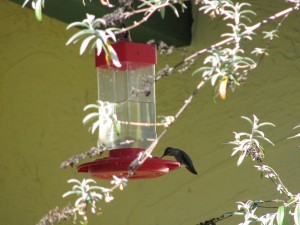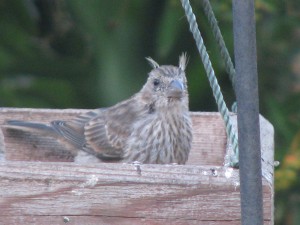Birds

Nesting season has begun. The raptors have been screaming and chasing each other for a couple of months now, making all the little birds uneasy. I’m not overly fond of crows (they are vicious to other animals for fun), but I respect them. These two have routinely preened each other on the telephone wire over my front yard for a couple of years. Now they are making a nest in the pine tree in my driveway. The weeds that I have pulled and tossed back onto the ground to decompose and return all that nutrition back into the soil, have become prime nesting material for Mr. and Mrs. Crow.
My front yard is a National Wildlife Habitat, with a plaque and all. Actually, you meet the qualifications of providing shelter, food, water and nesting areas, make a donation, and the National Wildlife Foundation sends you a plaque. Feels righteous anyway. In this yard we have a small pond, a multitude of bird feeders, and lots of bird and butterfly friendly plants. 
This yard is forever changing because I futz with it. My daughter and I dug and laid the pond (the flagstone and pond liner were free!), and I plant things, challenge them with neglect, and see what happens. We have so many feeders because from our dining room window we watch the birds. It is incredibly time consuming. You sit for a minute to watch some white crowned sparrows, and suddenly its two hours later. My daughter, who is studying Wildlife Conservation focusing on wild birds at Oregon State, is a far more intense birder than I am. She also participates in the Cornell University Project Feederwatch, and in her absence I do the counting on the weekends. http://www.birds.cornell.edu/pfw/ . She’s logged over 65 species of birds in our little front yard alone.

Migratory season has begun, and you should be seeing and hearing a lot more hummingbird activity. We have a couple of hummers who are year-round residents here in San Diego, most notably the Anna’s Hummingbird. If you see a hummingbird fly up incredibly high in the air then divebomb, and hear a small whistle followed by a chittering call, that’s our Annas.

They divebomb to protect territory and to impress the opposite sex. The whistle is made by the wind whistling through their tail feathers as they pull out of their dive; in fact, the height of their dive is probably to make a really impressive and fearsome whistle. Then they do their warbling chitter right after. Have to boast, after all. Here in North County you’ll see (and hear… he buzzes when he flies) the Rufous Hummingbird, Costa’s, and Black-Chinned. There are other varieties in other areas of San Diego as well, but these are the competitors around our house. And boy do they fight. Hummingbirds are so incredibly territorial that they will try to kill each other, then must fill up with nectar to feed that incredibly fast metabolism. During mating season they pretty much eat to fight. Its funny to see them call a temporary truce at the feeders so they can all drink, then go off and chase each other again. Hummers eat bugs, too. If you see one doing some weird flying in a place where there doesn’t seem to be any food, then they are probably gathering cobwebs which they use to line the insides of their nests, along with other things.

If you put up a feeder, you may want to consider a couple of things. One would be buying a feeder with bee guards, as in the above photo. Bees need food and water, too, and they love hummingbird feeders. However, sugar water is not good for bees or for their honey, and certainly not good for the hummingbirds. (I’ll talk about bees another time; I keep bees, too. I know, I know.) The above design hasn’t impressed me because the bottom tends to fall off, but there are better designs. You don’t have to buy nectar. Boil four parts water and add one part white sugar (not honey or brown sugar), then stir to dissolve and allow to cool to room temperature. You do not need to color the nectar red! Supplement the feeders with plants that hummers love such as fuchsias and hummingbird bush, so that they can feed on real nectar that has all the vitamins and minerals that they need. Always provide water, too, such as in a bird bath or a mister that they’ll love to fly through. If you do have a feeder, you must take care of it weekly in the wintertime, and every few days in the summer. Why? Because a black mold grows on the sugar water, especially where the hummingbird puts its beak to drink. That mold will cause a beak fungus that can be deadly to the bird. Instead of helping and enjoying the birds, you will be killing them. Mold is easily found floating in the water, clinging to the sides of the feeder jar, and blackening the feeding holes. To clean your feeders you should bleach them.

I fill half of my kitchen sink with hot water, dump in about 1/4 cup of bleach (I don’t measure), and then carefully without splashing on yet another shirt like my favorite purple tank top that now has a white spot on it, with rubber gloves on, I submerge the feeders and let them soak for about 15 minutes while I go off and forget they are there until I smell the bleach and remember. I use a long narrow bottle brush to clean the insides, and make certain that the feeding areas where their beaks will go in are scrubbed. Then I rinse everything in cold water and fill with the cooled sugar water and hang. If I’m coordinated enough I’ll line up other things that need bleaching so I don’t waste the water, such as something not-quite-white anymore, the cat food bowls and the compost bucket. Since my house is on septic I try to remember to put some of that black bacteria stuff down the drain afterwards.
Ants are a real problem with feeders, and the only organic thing I’ve found that really works is to coat the top of the feeder and the hook from which it hangs with Vasaline. During the really hot summers it does melt, so I have to reapply a couple of times, and make sure that nothing touches the feeders to give the little devils a bridge. But, it works! And without spraying poison.
Just to leave you with a happy image, here is a perennial bird favorite. The House Finches are all over Fallbrook; the males all colored up red in the front and the women daintily brown striped and everyone looking their most attractive as they choose their mates. Almost every year, however, some female will have an unfortunate molt. A bad feather day. Evidence of the cruelty of life without mirrors. We call the unfortunate one: Devil Finch.
